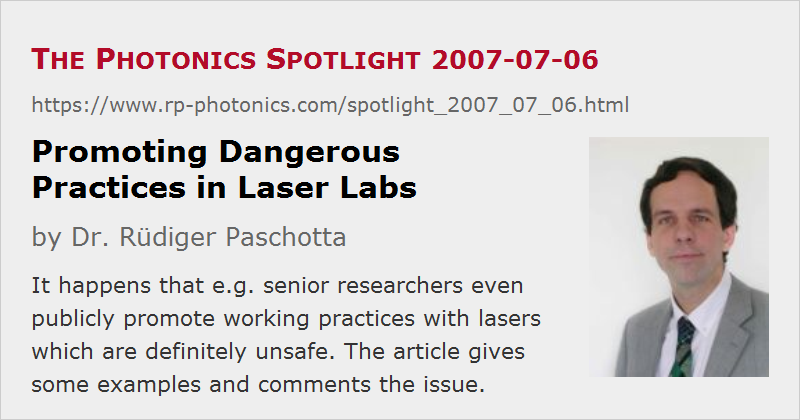Promoting Dangerous Practices in Laser Labs
Posted on 2007-07-06 as a part of the Photonics Spotlight (available as e-mail newsletter!)
Permanent link: https://www.rp-photonics.com/spotlight_2007_07_06.html
Author: Dr. Rüdiger Paschotta, RP Photonics Consulting GmbH
Abstract: It happens that e.g. senior researchers even publicly promote working practices with lasers which are definitely unsafe. The article gives some examples and comments the issue.

Ref.: encyclopedia articles on eye protection and laser safety; Wikipedia on laser safety
Most researches and laser engineers are well aware of laser safety issues, particularly the great hazards of laser light for the human eye. However, according to my experience it is still not uncommon to find people working with class-4 lasers (e.g. multi-watt infrared lasers in open lab setups) and not wearing laser goggles. It even happens that people more or less publicly promote working practices which are definitely rather dangerous in the sense of making possible serious eye damage with a small but not negligible probability. Just two examples:
- There are professors who routinely lead visitors through research laboratories with various dangerous lasers running, with no enclosure of hazardous areas, and nobody (including the visitors) using any kind of eye protection. This is done without making sure beforehand that no hazardous beam (e.g. due to some parasitic reflection) is leaving the setup. Of course, this causes an unacceptable risk for the unprotected visitors. Also, it is easy to imagine that such irresponsible behavior of superiors can have a quite bad impact on the developing habits of younger coworkers.
- An earlier version of the laser safety article in Wikipedia described it as common practice to work without eye protection in such labs, and made it appear as reasonably safe when some guidelines are observed, e.g. avoiding to lower the eyes to the horizontal plane to which the laser beams should be confined. This was obviously against all laser safety regulations, which do not allow that for good reasons; there are e.g. no practical ways of making sure that no dangerous beam can go upwards (into the eyes of the operator) while aligning a system or handling metallic tools in its vicinity. I modified that article in order to reduce the risk that such guidelines, breaching basic safety regulations, are perceived as being sufficient and recommended as such by experienced laser users. Unfortunately, some experienced laser users actually do recommend such practices, as the resulting discussion (see the discussion page) showed quite clearly: it is perceived as “moralizing” to support safety regulations against certain practices, and inappropriate to tell people what not to do.
By the way, I know a former colleague who worked exactly in this style with a 500-mW Nd:YAG laser: no safety goggles, just keep out of the horizontal plane of the beams and exert extra (unspecified) care when aligning a system. He was later told by a doctor that peripheral regions of both his retinas had been burned. He had not noticed that himself, but with somewhat less luck it could have hit the central portion of the retina, blinding him for ever.
Everybody may of course make up his or her own mind, but I insist on the following:
- It is one thing for an experienced user to breach some formal rules in special situations, keeping hazards for himself under control with suitable measures, and quite another thing to describe it as normal to ignore well-founded safety regulations.
- At the same time, I emphasize that it is also not sufficient for bosses to point at stringent regulations while not caring about how people can work with them in real life. (See the previous Spotlight article "Nonsensical regulations undermine laser safety".) Responsible behavior often requires more: to find practical solutions which are sufficiently safe at the same time.
- An “experienced user” is not simply one who has a sufficiently long record of ignoring hazards, but rather one who has learned to properly deal with them.
This article is a posting of the Photonics Spotlight, authored by Dr. Rüdiger Paschotta. You may link to this page and cite it, because its location is permanent. See also the RP Photonics Encyclopedia.
Note that you can also receive the articles in the form of a newsletter or with an RSS feed.
Questions and Comments from Users
Here you can submit questions and comments. As far as they get accepted by the author, they will appear above this paragraph together with the author’s answer. The author will decide on acceptance based on certain criteria. Essentially, the issue must be of sufficiently broad interest.
Please do not enter personal data here; we would otherwise delete it soon. (See also our privacy declaration.) If you wish to receive personal feedback or consultancy from the author, please contact him e.g. via e-mail.
By submitting the information, you give your consent to the potential publication of your inputs on our website according to our rules. (If you later retract your consent, we will delete those inputs.) As your inputs are first reviewed by the author, they may be published with some delay.
 |





If you like this page, please share the link with your friends and colleagues, e.g. via social media:
These sharing buttons are implemented in a privacy-friendly way!